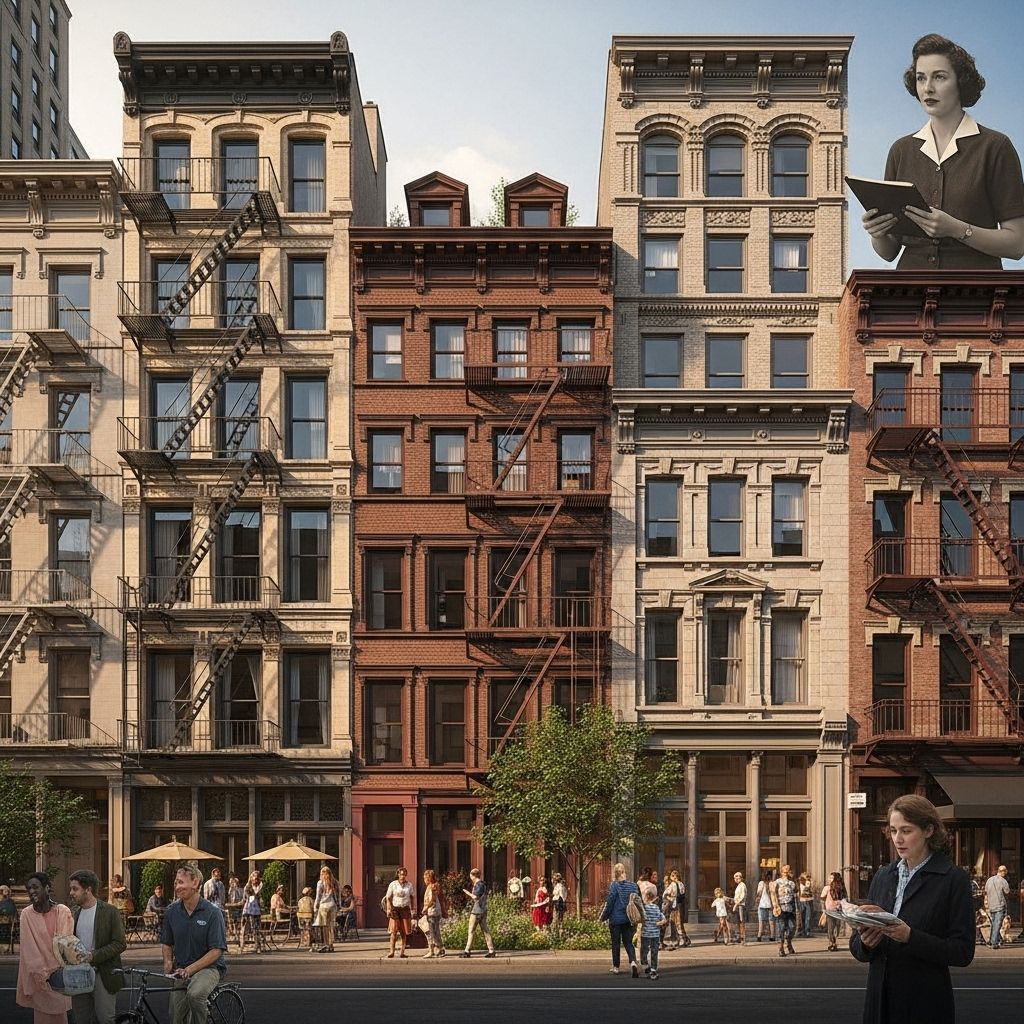Jane Jacobs, Gentrification, and the Vital Role of Old Buildings
How Jane Jacobs' insights on cities, diversity, and older buildings reveal the tensions and solutions behind gentrification and thriving urban life.

Jane Jacobs, a pioneering urban theorist, radically shifted how we think about cities, neighborhoods, and development. Her critique of top-down planning, championing of mixed-use neighborhoods, and defense of urban diversity continue to shape debates about gentrification and the value of old buildings. In this article, we examine Jacobs’ ideas, their legacy, and how they challenge and inform current conversations about urban change, with a particular focus on the tension between preserving city character and encouraging renewal.
Who Was Jane Jacobs?
Jane Jacobs (1916–2006) was an influential journalist, author, and activist whose critiques of post-war urban renewal transformed urban studies. Her most famous work, The Death and Life of Great American Cities (1961), called for cities to focus on the fundamental needs of their residents rather than centralized visions imposed by planners. Jacobs championed:
- Community self-determination over technocratic design
- Mixed-use development – combining residences, businesses, and public spaces
- Diversity in people, uses, and building types
- Grassroots activism to protect neighborhoods from destructive projects
Jacobs led citizens’ efforts that helped defeat New York’s Lower Manhattan Expressway and influenced similar activism internationally.
Gentrification and the Jane Jacobs Legacy
Today, gentrification—the process by which wealthier newcomers transform urban neighborhoods—is a flashpoint in debates about Jacobs’ work. Critics argue that Jacobs-style urban vibrancy can unintentionally spark the very forces of displacement she abhorred; supporters contend her ideas still offer essential solutions.
Jane Jacobs’ View of Gentrification
- She recognized the early signs of gentrification in Greenwich Village, observing aesthetic, demographic, and economic shifts.
- She cautioned that attempting to freeze neighborhoods in time—via restrictive zoning—was insufficient. Defensive tools must adapt to deeper economic dynamics.
- Jacobs championed “zoning for deliberate diversity”, which discourages monolithic development and instead preserves a mix of old and new buildings, uses, and populations.
The Dilemma: Diversity vs. Displacement
As Jacobs put it:
“The problem of the self-destruction of outstanding success is the problem of getting the supply of vital diversified city streets and districts into a saner relationship with demand.”
In other words, thriving neighborhoods become attractive, demand surges, and—absent intervention—prices rise, often displacing existing residents and businesses.
The Need for Old Buildings: Incubators of New Ideas
One of Jacobs’ most powerful and enduring arguments is the critical importance of old buildings for urban creativity and economic diversity. In vibrant city neighborhoods, different ages and qualities of buildings offer diverse opportunities:
- Low rents in older buildings allow for experimentation, risk-taking, and small-business innovation.
- Start-ups, artists, immigrant-run shops, and grassroots organizations can afford space only where costs are not prohibitively high.
- Older buildings help support a spectrum of income levels and uses, dampening runaway price escalation.
Jacobs wrote: “New ideas must use old buildings.” She observed that successful, resilient neighborhoods nurture new ventures precisely because their buildings are varied rather than homogenous.
Case Study: Greenwich Village and Beyond
- Greenwich Village thrived due in large part to its patchwork of aging apartments, lofts, and storefronts.
- This allowed an ever-evolving population and economic base: from student activists to jazz clubs to immigrant businesses.
- Preservation of this diversity, rather than blanket redevelopment, fostered innovation.
Urban Renewal vs. Organic Growth
Jacobs fiercely criticized top-down urban renewal—the practice of demolishing neighborhoods to build uniform, modernist complexes. She argued such interventions:
- Destroyed finely balanced urban fabric built up over time
- Erased local economies and forced out residents
- Emphasized speed and efficiency at the expense of grassroots complexity
The Value of Time and Accumulation
One of Jacobs’ key insights was the value of accumulated meaning, social ties, and history in neighborhoods. Thriving urban places result from decades of layered social and economic life—not instant “renewals.” Modern gentrification, when not thoughtfully managed, can destroy precisely this slow-built vibrancy.
Affordability, Ownership, and Public Policy
While Jacobs was wary of heavy-handed interventions, she did not oppose government action entirely. She:
- Advocated for affordable housing models—including subsidized apartments and neighborhood-led developments—to ensure diversity and resiliency.
- Called for tactical public investment in at-risk areas, adding and protecting affordability where displacement pressures emerge.
- Supported broad-based ownership and secure tenure for both homes and small businesses as tools against displacement.
From The West Village to Toronto: Action and Advocacy
- Jacobs championed New York City’s West Village Houses, a resident-led, affordable apartment project.
- Later, in Toronto, she supported public housing initiatives that conserved older homes and built new infill to enhance supply.
Her vision was pragmatic, balancing the rights of residents against large market forces and supporting institutional mechanisms that buttress local plans and businesses.
Scale, Governance, and Community Control
One often overlooked aspect of Jacobs’ thinking is her nuanced approach to the scale of urban government. She argued that:
- City districts should be small enough to be responsive to their constituents
- But also large enough to wield meaningful political power and resources
- This decentralization allows for policies uniquely tailored to each neighborhood’s needs and challenges
This approach counters both overbearing city-wide planning and the inertia of hyper-local, NIMBY-driven opposition.
Zoning for Diversity vs. Historic Preservation
Jacobs distinguished “zoning for deliberate diversity” from inflexible historic preservation. She observed that:
- While capping building heights can prevent urban “renewal” from erasing entire blocks, strict regulations can also preclude organic, small-scale adaptation
- Policies should aim to avoid both large-scale displacement and stasis, allowing neighborhoods to evolve in parallel with shifting social and economic forces
Her focus was on managing change inclusively rather than halting it outright.
The Deep Challenges of Modern Gentrification
Despite Jacobs’ caution, modern gentrification poses new complexities. Today, cities face:
- Accelerated neighborhood change, often driven by global capital, tech sectors, and high demand for urban living
- Rapid displacement of vulnerable communities, especially renters and small businesses
- The risk that “Jacobsian” vibrancy is commodified, losing its grassroots underpinnings
Displacement now refers not only to physical removal but also to subtle shifts in commerce, aesthetic, and neighborhood atmosphere. Long-standing communities find their daily lives reshaped, even if they remain in place.
The Role of Government and Market
Jacobs admired the ingenuity of ordinary city dwellers but recognized that government has a critical role in:
- Ensuring affordable housing supply, especially in quick-changing districts
- Intervening to support ordinary entrepreneurs facing displacement by large corporations
- Investing in both rental and ownership models to provide secure tenure
She argued that when local businesspeople thrive, they often invest back into their neighborhoods, contributing to a virtuous cycle of inclusive, dynamic growth.
Time, Complexity, and the Social Fabric
Jacobs’ enduring lesson is that thriving urban neighborhoods require time: for relationships, business networks, cultures, and physical fabric to be layered and interwoven. Abrupt redevelopment or unchecked market change threatens this delicate ecology. Effective urban policy:
- Preserves housing diversity and affordability across time, not just form
- Recognizes the slow-building value of social and physical infrastructure
- Promotes adaptation without sacrificing existing community networks
Preserving old buildings and a mix of uses is essential, but so is fostering new ideas and opportunities for all residents—not just newcomers or investors.
Frequently Asked Questions (FAQs)
Q: What did Jane Jacobs believe about gentrification?
A: Jacobs saw gentrification as a byproduct of urban vitality but warned against policies that either indiscriminately encouraged redevelopment or attempted to freeze neighborhoods in time. She advocated for balancing diversity, affordability, and organic change.
Q: Why are old buildings important to cities?
A: Old buildings provide affordable space for small businesses, cultural groups, and residents, supporting innovation, diversity, and economic resilience. They also anchor social networks and community memory.
Q: Was Jane Jacobs against all new development?
A: No. Jacobs objected to large-scale, top-down projects that destroyed neighborhoods but supported incremental, diverse, context-sensitive growth. She emphasized the need for a mix of old and new buildings and the importance of community voice in development.
Q: How should cities address displacement caused by gentrification?
A: Jacobs urged city governments to actively invest in local affordable housing and support small businesses to mitigate the risks of displacement, while also encouraging neighborhood self-determination and economic opportunity for all residents.
Q: What is ‘zoning for deliberate diversity’?
A: This concept involves designing zoning codes to maintain a healthy mix of building types, uses, and populations, preventing monocultures and allowing neighborhoods to evolve organically without sacrificing diversity.
Further Reading
- The Death and Life of Great American Cities by Jane Jacobs
- Essays on Jane Jacobs (2018)
- Urban Omnibus and VitalCityNYC articles on Jacobs’ legacy
- Case studies on Greenwich Village, West Village Houses, and Boyle Heights
References
- VitalCityNYC: Jane Jacobs Would Support ‘City of Yes’
- Urban Omnibus: What About Jane?
- Wikipedia: Jane Jacobs
- Substack: Urban Planning’s Struggle with Jane Jacobs
References
Read full bio of Sneha Tete












